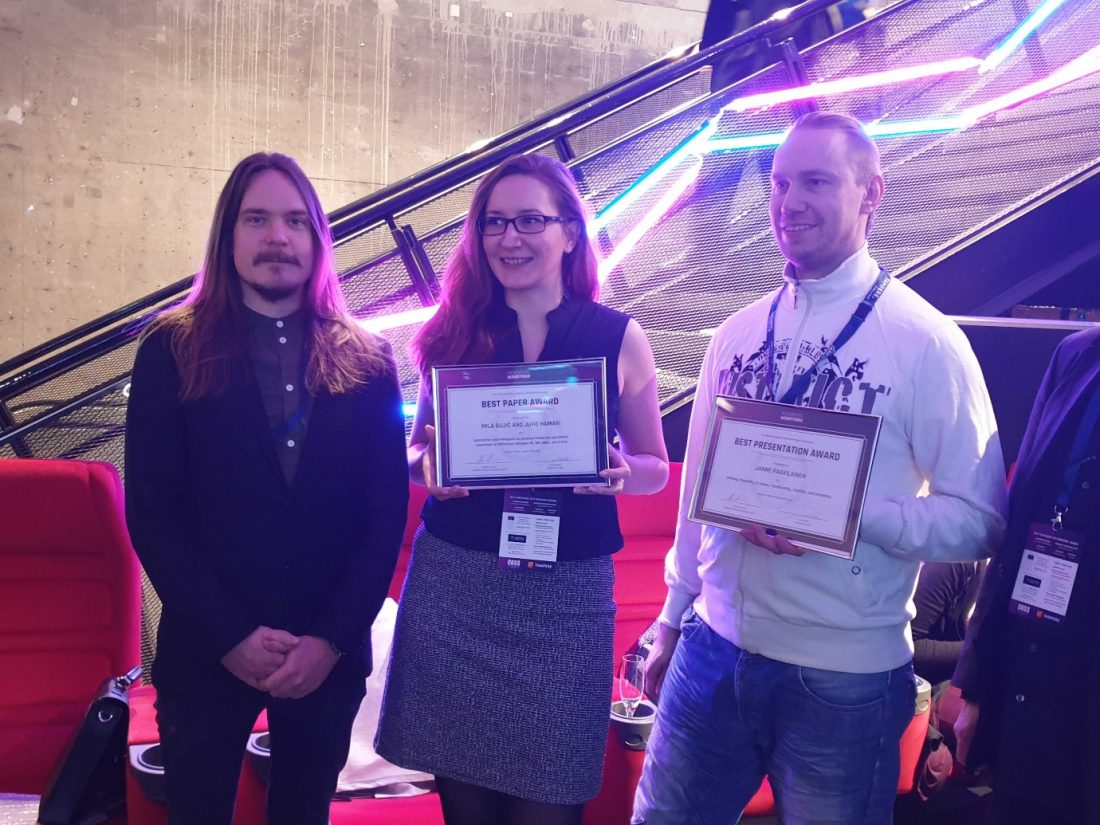
Best paper award: User satisfaction and continued use of immersive technologies and journalism
In the age of Internet and oversaturation with information, immersive media and technologies such as 360-degree videos and virtual reality (VR) are gaining more interest in the public. In particular, it is believed that they can help us pause, notice, and ultimately better grasp human experiences and situations distant from our own. However, it is unclear whether the public would be willing to continue use of such media instead or in addition to, for example, television or online and printed news.
During Academic Mindtrek 2020 in Tampere, Finland (29-30 of January) Mila Bujić presented a study co-authored with Juho Hamari that examined users’ satisfaction and intention to continue use of traditional and immersive journalism. The paper received the Best Paper Award.
Bujić and Hamari conducted an extensive experiment in comparing media experiences in an attempt to contribute to our understanding of advantages as well as pitfalls of the growing field and popularity of immersive technologies. For this purpose, they used a 360-degree video by The Guardian titled “The Sea Prayer“. It falls under an umbrella term of immersive journalism, which is used to describe all forms of presenting journalistic content using immersive media and technologies.

A video still from The Guardian’s The Sea Prayer
The promise of immersive journalism is in engaging users in a flood of information and content and bring closer issues of particular relevance or that are a point of public polarization, such as the immigration crisis. Both the example used in this study and the Oscar 2017 special award winner (Carne y Arena experience) deal with this particular topic. It is an attempt to surpass the less visible, or less felt, afflictions of distant groups and their individuals. In this sense, immersive technologies are posited as a unique way to bring down the abstract to concrete, global to individual, and distant to personal.
However, the use of similar media and technologies is not as widespread, nor a daily habit, as traditional journalism and its media are. As there is a growing interest for immersive journalism and at least several news media houses have engaged in its production, it seems necessary to assess whether it is possible to build a regular audience.
Hence, this study compared how users reacted to the in the core same content but in three different forms: as a written Internet news article, as a 360-degree video viewed on a computer screen, and as a 360-degree video viewed in mobile VR.
Bujić and Hamari found that participants reported that they were more likely to consume immersive journalism than traditional journalism, if given the chance. Surprisingly, they reported similar satisfaction with the three experiences. However, considering that their results were in line with numerous previous findings connecting higher satisfaction with higher intention to continue use, one explanation could be that the difference in satisfaction was too small to detect in the used sample. The difference in the intention to continue use of the three ways of delivering the content is the most distinct between the VR and article. Additionally, they analyzed if and how demographics factors influence the intention to continue use across all three media. Gender was found to have no effect, but younger users seem to be more likely to wish to consume similar content again.
Overall, it indeed appears so that users prefer immersive journalistic experiences over traditional ones, and that this line of both production and research, should be developed and expanded. Considering the goals of immersive journalism, this type of studies is not enough, although necessary. We should stay vigilant and further scrutinize what kind of prosocial behavioral effects, if any, might be instigated by immersive technologies.
User satisfaction and continued use of immersive technologies and journalism
Acknowledgements:
The study was partially supported by Business Finland as part of the Immersive project.
Reference: Bujic, M., & Hamari, J. (2020, January). Satisfaction and willingness to consume immersive journalism: Experiment of differences between VR, 360 video, and article. In Proceedings of the 23rd International Conference on Academic Mindtrek (pp. 120-125).
The conference paper is published in ACM and is available at:
Abstract
Immersive journalism has been touted to revolutionize journalism due to its ability to afford a multi-modal engrossing experience. However, hardly any experiments have been conducted whether consumers’ satisfaction and consequent intentions to use immersive journalistic media may differ from traditional forms of journalistic content. Therefore, in this study, we investigate the differences in satisfaction and continued use intentions between article, 360 video and VR-based interaction with content. The data was collected via a randomized controlled laboratory experiment with between-subjects design (N = 87). Participants were randomly assigned to reading a written article based on the video (article) and watching the video on a computer screen (2D 360) or in mobile VR (VR 360). The collected data consisted of demographics (age and gender) and reported satisfaction and intention to continue use. Results suggest that those who were assigned to VR 360 had higher intentions to continue use, but not greater satisfaction than those in the other two conditions. However, the intention was predicted to an extent by satisfaction as suggested by previous literature. Finally, age and gender did not predict continued use. These findings imply that users prefer the new media technology for consuming journalism content and support previous findings of the relationship between satisfaction and intention to continue use. Finally, avenues for further research are presented.




Sorry, the comment form is closed at this time.